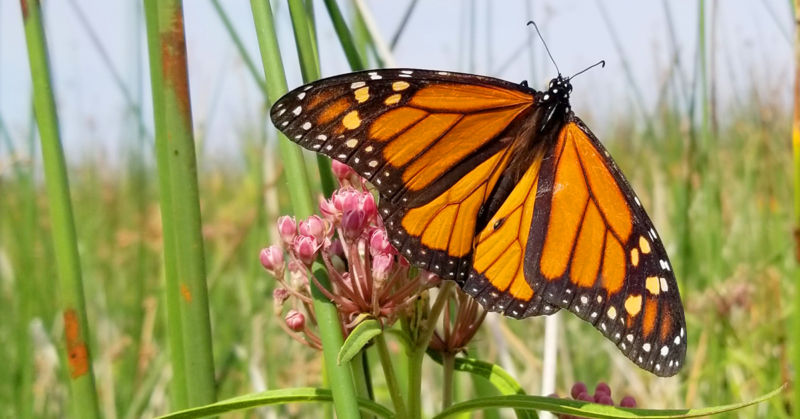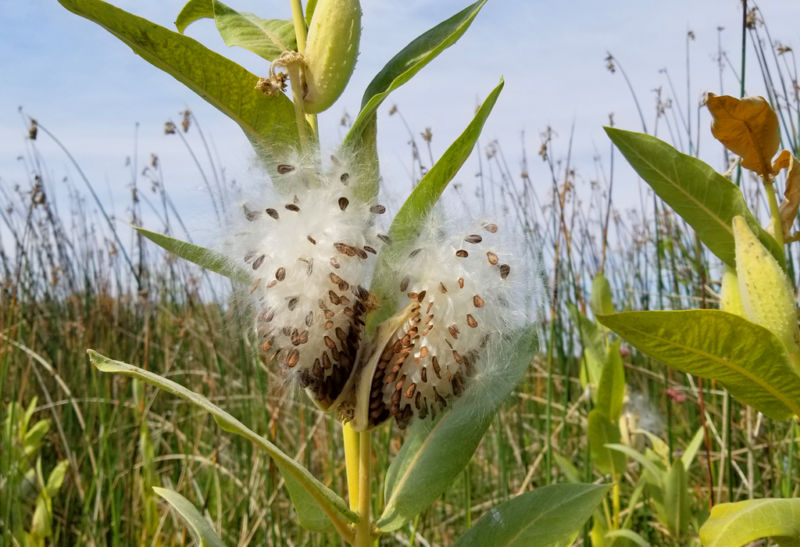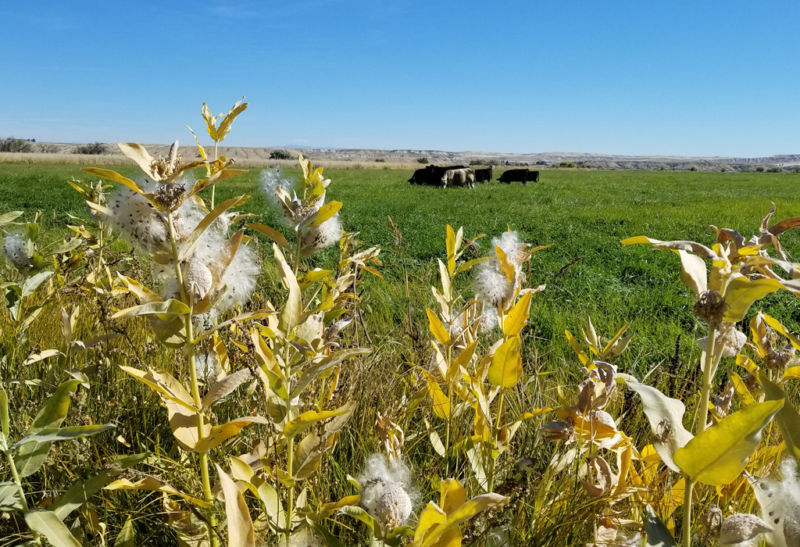
Friends for life: Monarchs and milkweed adapted to each other for survival. That relationship is more important than ever. Photo by Stephanie McKnight/Xerces Society
By Sue Kusch. July 9, 2020. The first time I noticed a milkweed plant I was cruising down a Forest Service dirt road on my way to a hiking trail. I braked quickly and backed up—common behavior for plant enthusiasts.
Standing alone in a ditch, the three-foot-tall stalk was topped by a large pink and white flower. It seemed so unusual I was certain it must be a rare species.
I grabbed my newly purchased wildflower guide, brushed off the layer of road dust on the leaves and flower and sat down to begin my identification effort.
New to the world of native plants, I was chastened to discover the plant I’d identified as milkweed was far from rare. In fact, it belonged to a genus of more than 100 species.
The diverse number of species live in a corresponding diversity of landscapes: wetlands, desert, mountain meadows, fields, open woodlands, along rivers and other sunny spaces of undisturbed land.

Free weed: A variety of wild milkweed species are native to the Columbia River Basin. Photo by Stephanie McKnight/Xerces Society
Milkweeds are grown commercially (mostly east of the Rocky Mountains) and used to make a variety of products: the seed floss is used in floating cleanup kits for oil spills and as a hypoallergenic filling for pillows and winter clothing.
The seed pods contain oil and wax, which are mechanically extracted and pressed into a rich oil commonly used in moisturizers. The de-fatted seeds are ground into a meal and used to kill nematodes and armyworms.
A broad range of milkweed species is native to the western United States.
“In the Columbia Basin, the most common species are showy milkweed, narrow-leaf milkweed and swamp milkweed,” says Stephanie McKnight, conservation biologist with the Portland-based nonprofit Xerces Society for Invertebrate Conservation. “Pallid milkweed occurs in the Columbia Basin but is rare.”
Evolutionary match: Milkweeds and monarchs
During the last three decades, milkweeds have commanded public attention because of their unique relationship to the monarch butterfly.
Milkweeds serve as the only host plant for the monarch butterfly caterpillar: a single egg is laid on the underside of a milkweed leaf. Once the egg hatches into a caterpillar it begins to feed on the leaves.
Named after the Greek god of healing, Asclepius, the common name, milkweed, is a reference to the milky secretion, called latex, found in the stems and leaves. That latex contains cardiac glycosides, a bitter-tasting chemical compound that can be toxic to some birds and other species when consumed.
The monarch caterpillar has developed the ability to sequester the latex and utilize it as a protection against its own potential predators, such as birds and mice, which spit out what they hoped would be a tasty meal. Evolved over millennia, this relationship serves as a classic example of co-evolution: a relationship in which plants and animals create adaptations to each other for their survival.
“The reason monarchs are so brightly colored is milkweeds are toxic,” says Scott Hoffman Black, executive director of the Xerces Society. “As monarch caterpillars eat the milkweed they concentrate those toxins in their bodies and become unpalatable. Basically that bright orange and black color tell birds, ‘That doesn’t taste good, I’m not going to eat that.’”

Tough spot: Monarch caterpillars on milkweed are increasingly rare. Photo by Stephanie McKnight/Xerces Society
Milkweeds have developed an additional strategy to dissuade predators.
“In milkweed plants, the latex is stored under pressure, so that when the leaves are broken—either by one of us as we pass by and pluck a leaf, or by the caterpillar that bites into the leaf, that latex exudes with some force,” says Dr. Anurag Agrawal, author of Monarchs and Milkweeds: A Migrating Butterfly, A Poisonous Plant and Their Remarkable Story of Co-Evolution.
Toxic latex aside, the plants remain appealing to an array of animals.
“Milkweed plants provide habitat for a variety of insects—butterflies, moths, bees, wasps, flies, true bugs, beetles, spiders, ants, mantids and lacewings to name the most common,” says McKnight. “Some of these are pollinators.”
But there’s a problem with both monarchs and milkweeds.
Monarch butterfly populations are dwindling. Alarmingly.
And while milkweeds remain prevalent in the Columbia River Basin, native species face increasing pressures from the development of subdivisions and commercial areas. Pesticides use in agricultural and suburban zones also destroys milkweeds and habitat crucial to monarch butterflies and other pollinators.
“There’s over-grazing in the Columbia River Basin, and there’s a lot of highly toxic insecticides used in agricultural areas,” says Black. “But looking at U.S. Geologic Survey data, urban and suburban areas often have as high or higher levels of pesticide use. It’s not just a matter of pointing a finger at a farmer.”
Natural wonder under threat
Each fall, monarch butterflies migrate from summer habitats in the Columbia River Basin to overwintering grounds. Though some will make it as far south as Mexico, the vast majority will arrive at overwintering grounds in California, stretching from coastal locations around the Bay Area as far south as San Diego.
“If you’re talking about monarch butterflies in the Columbia River Basin, you have to talk about California,” says Black, adding that loss and degradation of overwintering sites in California results in fewer monarchs migrating north.
“We’ve gone from likely around 4.5 million monarchs in the Northwest that overwinter in California (in the 1980s) to this last year around just 30,000,” says Black. “That’s a pretty drastic drop.”
[perfectpullquote align=”full” bordertop=”false” cite=”” link=”” color=”” class=”” size=””]You’re not imagining it—monarch butterflies really are disappearing.[/perfectpullquote]
Part of broader monarch movements in the West—which stretch from Canada to Mexico—the butterflies’ migration is one of the world’s great natural wonders. That wonder is now in crisis.
“In the winter of 2018, and again in 2019, the western monarch overwintering population has reached the lowest level ever recorded—less than 1% of historic populations, and a dizzying 86% drop from the year prior,” according to the Xerces Society.
In March, Xerces reported the number of monarchs spending the 2019-20 winter in Mexico had fallen by 53% over the previous year.
“Monarchs are not recovering and still urgently need Endangered Species Act protection in the United States and extraordinary conservation efforts,” said the organization.
Will enough habitat remain?
Without plentiful milkweeds in seasonal breeding areas, monarchs aren’t able to reproduce in significant numbers.
Monarch Watch is a nonprofit conservation and research program based at the University of Kansas that focuses on the monarch butterfly. Its Monarch Waystation project encourages planting patches of milkweed native to each region “in home gardens, at schools, businesses, parks, zoos, nature centers, along roadsides and on other unused plots of land.”
The Western Monarch Milkweed Mapper, a community science project with multiple partners managed by the Xerces Society, is focused on collecting data from citizens living in western regions on sightings of both monarchs and milkweeds.

Resilient not indestructible: Over-grazing is one of a number of practices that threaten milkweed habitat. Photo by Stephanie McKnight Xerces Society
In the Columbia River Basin, Black says better stewardship of existing milkweeds habitat is the most effective way to protect or restore monarch populations.
“I’ve been trying to steer these conversations to ‘let’s protect what remains in natural areas, on roadsides, on U.S. Forest Service or BLM lands,’” he says. “It doesn’t hurt to go out and plant milkweeds. But it’s harder and more expensive to do restoration than protection.
“Milkweeds are vital in the Columbia River Basin for monarchs. We need a diversity of native milkweeds across these landscapes … if we lose milkweeds in the Basin we’re not going to have monarchs.”
The Monarch Waystation and Western Monarch Milkweed Mapper projects offer simple opportunities to participate in conservation efforts for both the eastern and western populations.
If nothing else, Robert Pyle, lepidopterist, Xerces Society co-founder and author of Chasing Monarchs, reminds us that milkweeds are more than just a pretty flower.
“Our milkweed species, while patchy and limited in their Washington occurrence, comprise a valuable and significant component of our flora,” Pyle has written. “Both showy and narrow-leaved milkweed are superb nectar plants for an array of other butterflies as well, and for many other pollinators.”
As for the monarchs, if they’re to bounce back in the West, milkweeds will be the key.
A former college educator and adviser in Vancouver, Washington, Sue Kusch cultivates edible, medicinal and native plants. She currently serves as president of the Suksdorfia Chapter of the Washington Native Plant Society.






